smuv
National Hazard
   
Posts: 842
Registered: 2-5-2007
Member Is Offline
Mood: Jingoistic
|
|
Toluene --> Sodium Tosylate --> p-cresol
I needed a simple phenol to run some alkylation experiments. Therefore, I decided to make p-cresol. To do this, I synthesized sodium tosylate from
toluene and sulfuric acid. The p-cresol was subsequently prepared by alkali fusion of the sodium tosylate.
The procedure for sodium tosylate was taken for vogel. The vogel procedure is complete bullshit, don't even read it, it is clear that whoever wrote
it had never actually performed the synthesis. The p-cresol procedure is from orgsyn, it is a good procedure.
Sodium Tosylate
A mixture of 70 mL conc. H2SO4 and 140 mL of toluene was refluxed for one day under vigorous stirring in a 500 mL flask. After reflux, the mixture
had become nearly homogeneous with only a very small amount of unreacted toluene (say 5 mL). The solution was allowed to cool, causing it to solidify
in the flask as wet crystals. The crystals were transfered to a 1L beaker by washing out the flask with 3x100mL water (some exotherm upon addition of
water, but manageable without ice-cooling). This aqueous solution of tosic acid was diluted to 500 mL with water and then partially neutralized by
the careful addition of 60g NaHCO3 under vigorous stirring. Next, 200g of NaCl was added and the solution was boiled until completely saturated with
salt. The mixture was quickly vac filtered through a buchner funnel (preheated by filtering boiling water moments before filtration of this product
*switch receiving flasks*). The filtrate was allowed to cool on an ice bath for a few hours (btw: the filter cake was predominantly undissolved
NaCl). The thick crystalline mass was broken and then separated from the supernatant solution via vac filtration, with the filtrate used to complete
the transfer. The filter cake was sucked fairly dry, washed with the minimum amount of conc. brine to just wet all the product (~50-100 mL) and then
sucked as dry as was reasonably possible. The crystals were added to ~425 mL of water and the mixture was bought to a boil under vigorous stirring.
NaCl was added portionwise until the solution had just saturated; at this point another 25 mL of water was added. The mixture was allowed to
crystallize at room temp for ~12 h and then at ~0c (outside on winter day) for another 12h. The crystals were collected via vac filtration and washed
as previously with conc. brine, sucked as dry as possible and then washed with 50mL of cold denat. ethanol (sodium tosylate is very sparingly soluble
in cold ethanol). After being sucked dry, the crystals were further dried in a warm place, and finally in the oven for a few hours at 200c (this is
almost unnecessary, they are quite dry after standing on a radiator). In total 124.9g (49% yield) of sodium tosylate was recovered as a colorless
crystalline powder.
The product melted at a very high temp ~300c. When a spatula-full of sodium tosylate was placed in a bunsen burner flame, strong direct heating was
required to get the Na Tosylate to burn, even then, when removed from the flame it would eventually self extinguish.
I ran this again on double the scale; I only recovered 200g, because of mechanical loses (over-filled buchner) and because my final product got rained
on while recrystallizing (I thought it was going to snow, there were apparently some holes from corrosion in the aluminum foil covering the flask).
That being said I made some changes. First, after reflux instead of shutting everything down, I set-up for simple distillation and removed the
toluene (without doing this the unreacted toluene evaporates during the neutralization, stinking up the lab). Also, I skipped the ethanol wash, it is
an unnecessary step and useless if you just leave it on the pump to dry. I would also recommend to anyone trying to repeat this to use more sulfuric
acid to try to get all the toluene to react (say 10% more, remember to use 10% more bicarbonate during neutralization).
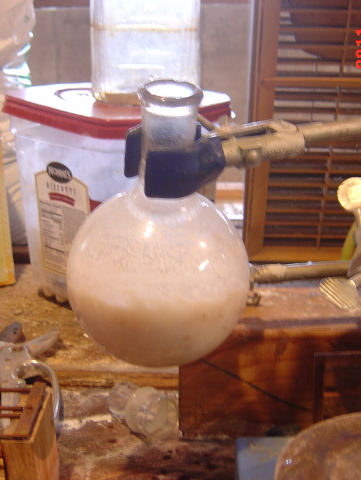
Cooled after reflux, showing soldified toluenesulfonic acid.
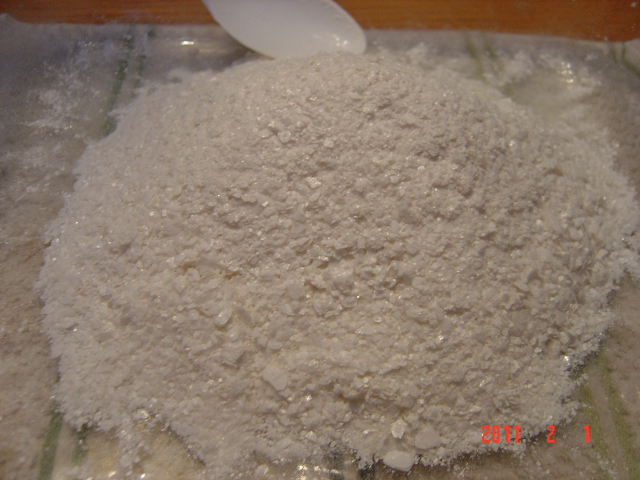
Final product after recrystallization.
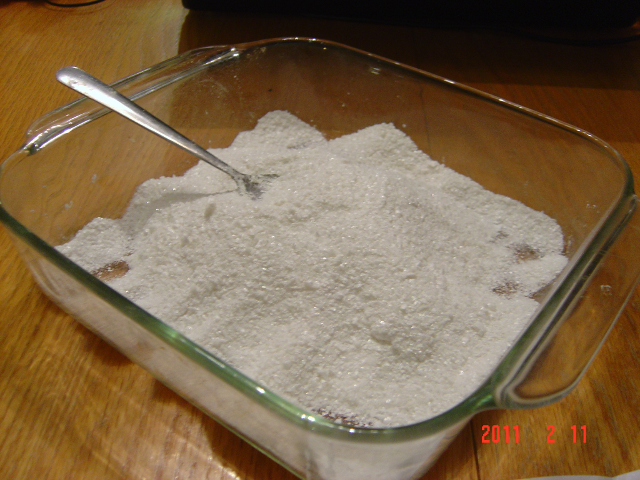
Product from second batch on double scale
p-cresol
Setup
I did this in a silver plated copper basin ($3 thrift store  ). I set this over
a bunsen burner with clamps, and then used aluminum foil to provide a "skirt" along the perimeter of the basin to help keep the heat in and stop the
sides from cooling (causing caustic to cake up, unmelted). The thermometer was protected by inserting it into a piece of copper tubing crimped at the
end by a vice; the middle portion of the thermometer was further protected (from splattering base) with aluminum foil. The spoon seen in the pictures
below is totally unnecessary. I stopped using it early on; the thermometer is more than sufficient to stir the reaction mixture. ). I set this over
a bunsen burner with clamps, and then used aluminum foil to provide a "skirt" along the perimeter of the basin to help keep the heat in and stop the
sides from cooling (causing caustic to cake up, unmelted). The thermometer was protected by inserting it into a piece of copper tubing crimped at the
end by a vice; the middle portion of the thermometer was further protected (from splattering base) with aluminum foil. The spoon seen in the pictures
below is totally unnecessary. I stopped using it early on; the thermometer is more than sufficient to stir the reaction mixture.
Procedure
A mixture of 80g of KOH and 200g of NaOH was melted in the basin (heated by bunsen burner). The burner flame was adjusted to maintain a steady 230c
and 120g of sodium tosylate was added in portions while slowly increasing the temperature of the melt. The melt was pretty vigorously stirred with
the thermometer, no spattering was noted during the addition. As the addition continued the melt progressively got thicker and thicker with
undissolved crap, after addition (I didn't time it) the temp of the melt was raised to 330c. At this point the melt was not homogeneous, but I
freaked out because the melt had darkened somewhat, so I (prematurely) poured the melt onto a big cast iron lid.
After solidifying the melt was scraped off of the lid with a SS spoon (MASSIVE PITA), and dissolved into 1.5 L of water (watch the exotherm, do this
in portions). The solution was allowed to cool to room temperature (don't worry if every last bit of the melt hasn't dissolved) and 180 mL of conc.
sulfuric acid diluted to 600 mL with cold water was added portionwise (exotherm). Then small portions of conc. H2SO4 were added until a persistent
(not fleeting, must be persistent) smell of SO2 is noted. This mixture was transfered into a 3L flask and diluted to ~2300mL. The p-cresol was
separated by steam distillation, it came over as a yellow green oil. The distillation was tracked by treating portions of the distillate with bromine
water, really though this is too sensitive. The distillation is done when the distillate is no longer milky looking (no longer a suspension). The
distillate (ca 1.5L) was saturated with NaCl and the p-cresol was was separated from the brine. The brine was extracted with 1x25 mL of toluene (just
to pick up whatever cresol was emulsified). The extract was combined with the oily cresol and then vac distilled. Once all the toluene had been
removed, the apparatus was setup for short-path vac distillation, an intermediate fraction was collected (toluene to 112c, < 1g) and finally the
product was collected at 112-114c (don't know pressure). The product crystallized on cooling. In total 12.5g (v. low yield) of p-cresol was
recovered as a colorless, peculiar (mostly unpleasant) smelling solid. The product was found to be one spot (though some "ghosting" near baseline) by
TLC (neat DCM).
What I did wrong/what I would change
The sodium tosylate is only sparingly soluble in the reaction melt, the orgsyn procedure has been optimized to minimize the amount of KOH used.
Sodium tosylate is way less soluble in NaOH than KOH. As a consequence of this procedure it is hard to get all the sodium tosylate to dissolve. The
sodium tosylate must dissolve to react. I stopped the reaction way too early (because I wasn't keeping track of time). If in doubt this reaction
should be run too long. A little product lost to oxidation in the melt is acceptable when compared to having loads of unreacted starting material as
I did. When I was doing the reaction, I didn't have a great handle on the factors at play, so immediately when I saw some mild darkening I said OMG
I'm overcooking it and stopped the reaction. When I consider how tedious this workup is I REALLY regret this. When I do this again, I will do it in
a pure KOH melt (enough to make it the same volume as the melt in the orgsyn procedure), and I will absolutely under no circumstances stop the
reaction before with any undissolved solids present. That being said, if you follow the orgsyn procedure to the letter, I am sure it will work as
reported.
Also, this is a long procedure, I spaced everything out over the course of many many days. This was bad, I knew it, but free time was scarce. If you
can fit the whole procedure into a day (it would be 12h of work or more) go for it. If not, try to give yourself 8-9 hours to do everything through
the steam distillation and then you are at a good stopping point and can do the vacuum distillation at your leisure. Having cresol suspended in
strongly alkaline and fairly acidic solutions is going to decompose it over long periods.
One thing I underestimated is how rank the smell of p-cresol is. At first it is acceptable, but the problem is it is such a lingering smell.
Finally I ran into some difficulties with the vacuum distillation (my first in an amateur setting). At first I didn't grease the joints, this was
fine, for stripping toluene (at less <40c) but once product started coming over I noticed my joints started smoking! The cresol which had worked
its way into my joints through capillary action was decomposing in contact with air. Because of this I had to quickly shut everything down. I
greased the joints with "plumbers silicone grease" and this worked phenomenally. To compound this hiccup when I was disconnecting the vacuum hose at
the end of the distillation, shifted the apparatus causing a good amount of product to be sucked into my cold-trap.
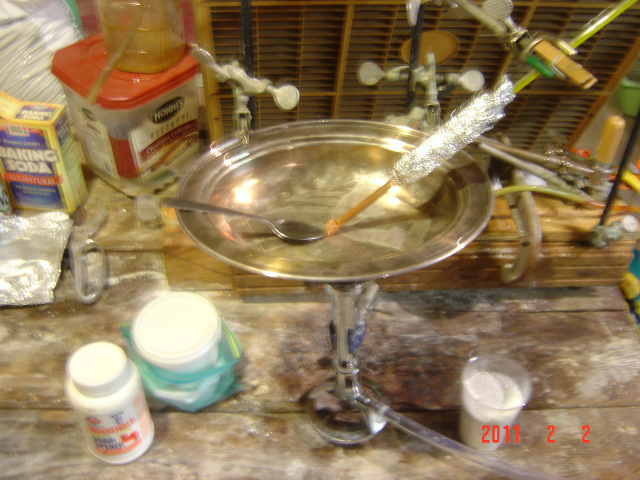
Blurry setup (not showing aluminum foil skirt)

Progression of the reaction, don't make my mistake, no matter what only stop when melt is homogeneous!
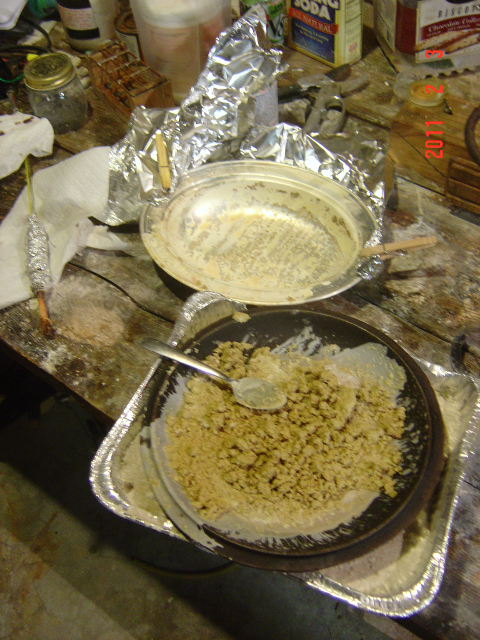
Solidified semi-broken-up melt. What a pain in the ass
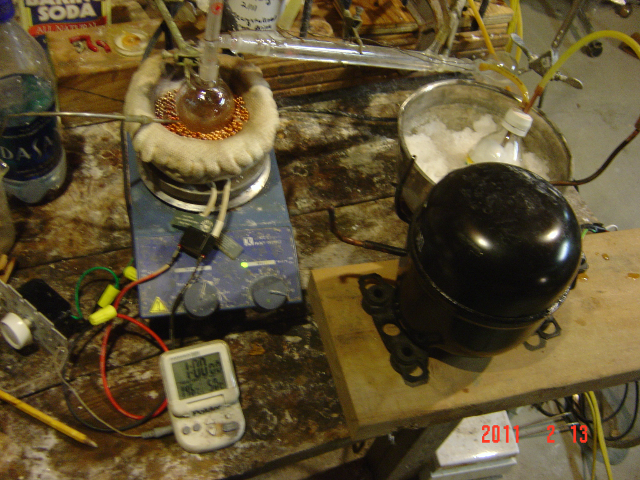
Toluene stripping
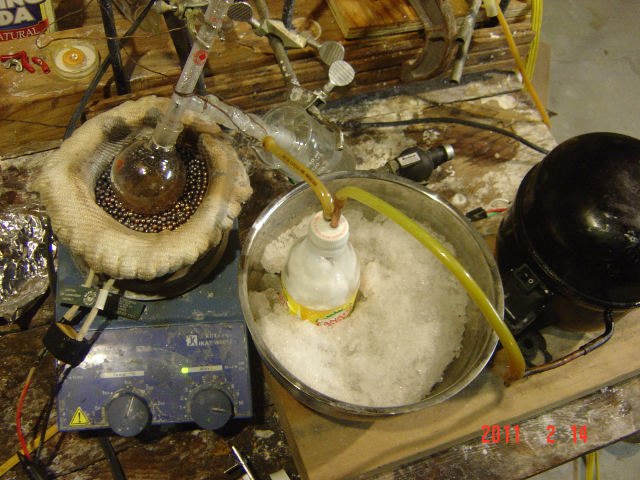
Collecting cresol via improvised short path distillation. It worked pretty well.
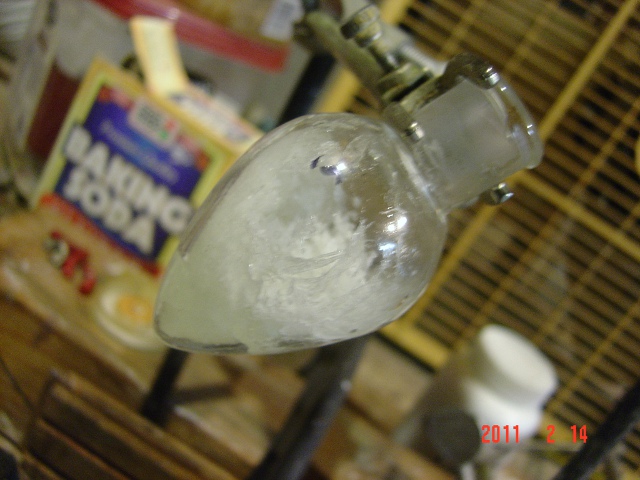
Product in receiving flask
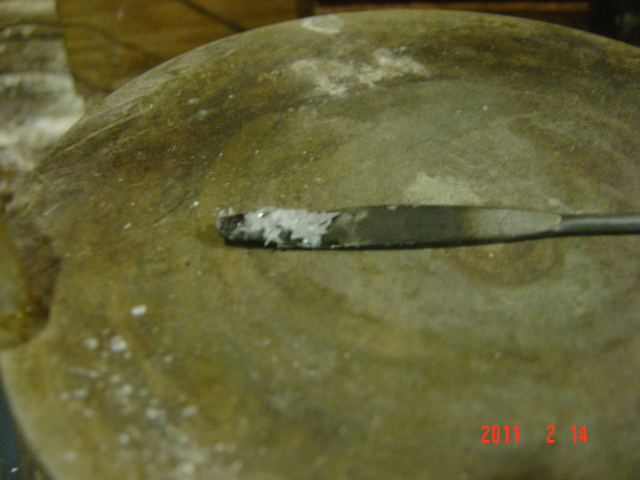
Some product on a spatula
[Edited on 2-15-2011 by smuv]
|
|
|
garage chemist
chemical wizard
    
Posts: 1803
Registered: 16-8-2004
Location: Germany
Member Is Offline
Mood: No Mood
|
|
Great job with the pictures and the detailed synthesis report!
Your chosen method of sodium tosylate synthesis is an interesting alternative to the textbook preparation of p-TsOH from toluene and H2SO4 using a
Dean-Stark trap.
When no more water is collecting in the trap (all H2SO4 has reacted), one adds a small, carefully measured amount of water to the mix after cooling
which makes the p-TsOH crystallize from the excess toluene as the monohydrate. The byproduct o-TsOH does not form such a hydrate and stays in
solution.
The filtered crude p-TsOH*H2O is then purified by dissolving it in half its own weight of water and saturating the solution with HCl gas.
If your cresol has the correct melting point then you know that you've isolated the p-TsONa in sufficient purity.
I'm wondering, which step in this synthesis separated the isomers, and what is the principle behind it?
The next time you do the sulfonate + caustic melt, make a test run with small amounts and heat it properly hot and long. Do a rudimentary workup
(dissolve, acidify, add salt and separate phases) to see whether this has given a good-looking yield.
One little correction: you wrote that you saturated the steam distillate with sodium hydroxide. Surely you meant NaCl?
|
|
|
entropy51
Gone, but not forgotten
    
Posts: 1612
Registered: 30-5-2009
Member Is Offline
Mood: Fissile
|
|
Fantastic writeup, smuv.
I like your vacuum pump! Is that copper shot you're using for heat transfer in your heating mantle?
|
|
|
bahamuth
Hazard to Others
  
Posts: 384
Registered: 3-11-2009
Location: Norway
Member Is Offline
Mood: Under stimulated
|
|
Nice writeup.
Started the synthesis of p-cresol myself, but also wanted some anhydrous tosylic acid for other stuff so did it according to Vogel with a improvised
Dean Stark, worked well IIRC, do not know where I have my notes ATM though, so can not report any yields.
Got quite a lot of charring, which partially was removed by recrystallization from water saturating it with HCl gas, note that this is not something
to do on your kitchen bench as I did, figured that I would be able to contain the gas, which I did until I took the apparatus apart...
For the tosylic acid, it is still resting in the desiccator over KOH/CaCl2 as I found it extremely hygroscopic.
Like your way of solving the issue with a silver container for the fusion, and also now I have the incentive to finish the synthesis myself between
school and work..
Edit:
Apparently tosylic acid is not so hygroscopic as previously experienced, as I just transferred them to a suitable container.
Thinking it could very well have been residual HCl trapped in the semi large crystals making them melt in contact with air
[Edited on 15-2-2011 by bahamuth]
Any sufficiently advanced technology is indistinguishable from magic.
|
|
|
Magpie
lab constructor
    
Posts: 5939
Registered: 1-11-2003
Location: USA
Member Is Offline
Mood: Chemistry: the subtle science.
|
|
Nice going smuv and thanks for the write-up.
I also did an alkali fusion, using NaOH and disodium m-benzene disulfonate to get resorcinol. My fusion vessel was a 3.5" cast iron Lodge frying pan.
Since I needed a temperature of 310C and the mp of NaOH is 318C I just provided enough heat to keep the mix molten. I did measure it a few times
with a TC and it was right in the 300-330C range. I used a glass stirring rod to keep it mixed and was surprised that this was not severely attacked.
How did your thermometer make out in that molten KOH? I heated the melt for 1.5hrs. My original plan was for 2 hours but I got tired of standing so
quit early.
I will also provide a write-up when I have completed the synthesis and can report the yield and purity.
[Edited on 15-2-2011 by Magpie]
The single most important condition for a successful synthesis is good mixing - Nicodem
|
|
|
smuv
National Hazard
   
Posts: 842
Registered: 2-5-2007
Member Is Offline
Mood: Jingoistic
|
|
Thanks everyone!
@GC The purification is a simple recrystallization, the ortho and meta sulfonates are much more soluble than the para species. On top of that, in
refluxing toluene/sulfuric acid the high temp strongly favors para formation. A better procedure than Vogel (which explains this part) can be found
in the book by Fieser in the forum library.
You are right about that error, I will edit it.
@Entropy, I don't know if they are copper (probably plated), but they are BB's for airguns. They work much better (and less mess) than sand. The
pump is from a wine cooler I found in the dump. I had to manually add a switch to energize the start-up coil of the pump to allow it to start (this
is probably why it was thrown away in the first place). For vac filtrations it is great, for distillations it is so-so. The pump is capable of lower
pressures than I was using it at, but at low pressures the vacuum pressure fluctuates a lot (the pump cannot maintain a consistent rpm, you can hear
it racing), so the tubing must be adjusted to allow a tiny leak to avoid this.
@bahamuth, I recommend that you go the route I did, without isolating the free acid. I did not notice charring (in fact I skipped the activated
charcoal step). The sodium tosylate synthesis is fun, pretty easy and provides nice looking crystals.
@Magpie, the thermometer came out fine, no change at all. The copper tubing was crimped well, no caustic was able to touch it. I look forward to
reading your writeup. Its great that you made both the benzene and SO3 starting materials for you synthesis.
[Edited on 2-15-2011 by smuv]
|
|
|
Magpie
lab constructor
    
Posts: 5939
Registered: 1-11-2003
Location: USA
Member Is Offline
Mood: Chemistry: the subtle science.
|
|
This surprises me. I severely frosted one of my good high-temperature thermometers using it as a stirring rod for fused alkali. I'll have to go back
in my notebooks to find the conditions.
Not the benzene. I stopped making that years ago along with glacial acetic acid. 
The single most important condition for a successful synthesis is good mixing - Nicodem
|
|
|
smuv
National Hazard
   
Posts: 842
Registered: 2-5-2007
Member Is Offline
Mood: Jingoistic
|
|
Read the setup/look at the pictures, the thermometer is protected from the alkali by a copper tube crimped at one end.
|
|
|
Magpie
lab constructor
    
Posts: 5939
Registered: 1-11-2003
Location: USA
Member Is Offline
Mood: Chemistry: the subtle science.
|
|
Quote: Originally posted by smuv  | | Read the setup/look at the pictures, the thermometer is protected from the alkali by a copper tube crimped at one end. |
Oops - sorry. I see that now.
I could not find anything in my notebooks but suspect it occured during my attempts to make electrochemical sodium about 5 years ago. The thermometer
case itself I marked "tip eroded by molten NaOH."
The single most important condition for a successful synthesis is good mixing - Nicodem
|
|
|
bfesser
Resident Wikipedian
    
Posts: 2114
Registered: 29-1-2008
Member Is Offline
Mood: No Mood
|
|
I'm planning on following either your synthesis, smuv, or an adaptation of Vogel's. I have a question, however. Why exactly does Vogel call for
thiophene-free toluene in the preparation of sodium p-toluenesulphonate? Would it hurt to use distilled hardware store grade toluene with the same
procedure?
|
|
|
benzylchloride1
Hazard to Others
  
Posts: 299
Registered: 16-3-2007
Member Is Offline
Mood: Pushing the envelope of synthetic chemistry in one's basement
|
|
Excellent work and write up. I ran this same synthesis about eight months ago. It takes a long time for the sodium p-toluene sulfonate to dissolve in
the NaOH/KOH melt. The lingering smell is horrible, my dad thought that the odor was reminiscent of burro dung. The procedure that I used was taken
word for word from Vogel's. I methylated the p-cresol that I obtained using methyl iodide and sodium methoxide as the base. I plan on doing a Birch
type reduction of the p-methyl anisole to make the diene which will then be isomerized to the conjugated diene which I plan on using the make a iron
tricarbonyl complex out of. I have seen a procedure for running a Birch type reduction of an aromatic system using sodium amalgam in Orgsynth. I
wonder if this would work for this substrate.
Amateur NMR spectroscopist
|
|
|
Magpie
lab constructor
    
Posts: 5939
Registered: 1-11-2003
Location: USA
Member Is Offline
Mood: Chemistry: the subtle science.
|
|
I wonder why? Doesn't OrgSyn say it smells like a typical phenol. I don't find phenol unpleasant at all.
Good work, both of you. I will be back on the trail of fusions to make resorcinol when the weather cools off and I can get back in my lab.
Here's something I found interesting/relevant. Sorry I can't post it but only have it in PDF:
http://pubs.acs.org/doi/abs/10.1021/ie50517a056
The single most important condition for a successful synthesis is good mixing - Nicodem
|
|
|
smuv
National Hazard
   
Posts: 842
Registered: 2-5-2007
Member Is Offline
Mood: Jingoistic
|
|
@ Bfesser: Modern aromatics don't likely contain thiophene . This was brought up in another thread (thread), essentially processes has changed--aromatics are made from petroleum these days, not coal. Also, I used toluene right from the bottle
(hardware store).
@Magpie: p-cresol smells really bad. It does have a lingering smell too. I think I read somewhere (probably wiki) that it is in pig sweat and gives
its characteristic smell.
[Edited on 8-20-2011 by smuv]
"Titanium tetrachloride…You sly temptress." --Walter Bishop
|
|
|
MeSynth
Hazard to Others
  
Posts: 107
Registered: 29-7-2011
Member Is Offline
Mood: http://www.youtube.com/watch?v=5ZltqlVuDIo
|
|
Is it possible to synthesize any other isomers using sodium tosylate as the starting material? To the best of my memory there are two others. o and
another that I dont remember. let me check. the other is m.
|
|
|
DJF90
International Hazard
    
Posts: 2266
Registered: 15-12-2007
Location: At the bench
Member Is Offline
Mood: No Mood
|
|
No its not possible directly to form the other isomers from sodium p-tosylate.
Toluene should probably be purified as in Perrin's as even some lab grade toluenes give a dark colouration on mixing with concentrated sulfuric acid,
due to impurities. On a separate note, recrystallisation by gassing a concentrated aq. solution of TsOH with HCl is just plain nasty and should be
avoided. Vacuum filtration of the precipitate causes choking and rapid rusting in the vicinity, especially if using a ptfe diaphragm pump with no
traps. The method utilising a saturated aqueous solution of TsOH, and crashing out by adding three(?) volumes of conc. HCl is not particularly
pleasant for the same reasons. I also found that the collected precipitate rapidly liquified, even in a desiccator over CaCl2/NaOH. Over time, a oily
liquid appeared onthe inside of the desiccator, reminiscent of toluene, although no efforts were made to ascertain its identity.
|
|
|
MeSynth
Hazard to Others
  
Posts: 107
Registered: 29-7-2011
Member Is Offline
Mood: http://www.youtube.com/watch?v=5ZltqlVuDIo
|
|
This chemical p-cresol is the key component of stench in pig buisness.. and look how he made it with out a fume hood. hehe
|
|
|
smuv
National Hazard
   
Posts: 842
Registered: 2-5-2007
Member Is Offline
Mood: Jingoistic
|
|
| Quote: | | recrystallisation by gassing a concentrated aq. solution of TsOH with HCl is just plain nasty and should be avoided. |
If you let the reaction mixture cool (in the synth I posted), a lot of TsOH precpitates, to the point that the reaction mixture becomes a solid mass.
I am sure if I filtered this through fritted glass, I would get quite good yields of TsOH. After washing in the funnel (I would probably do conc.
HCl, then cold ether) I think this product would be pure enough for most purposes.
"Titanium tetrachloride…You sly temptress." --Walter Bishop
|
|
|
redox
Hazard to Others
  
Posts: 268
Registered: 22-2-2011
Location: The Land of Milk and Honey
Member Is Offline
Mood: Chalcogenetic
|
|
I performed this synthesis today, but I did it slightly different from Smuv. 
I added 92 grams (1 mol) of toluene and 98 grams (1 mol) of sulfuric acid to a 250 mL round bottom flask.

By louf11 at 2011-08-21
Here you can see the reactants.

By louf11 at 2011-08-21
The RBF was connected to a dean-stark apparatus, condenser, claisen, and thermometer. The reactants were heated for approximately 3 hours and 45
minutes under vigorous magnetic stirring. The reflux was stopped when the calculated 18 mL of water had collected in the dean-stark trap. The trap had
to be drained after the first 12 mL due to the trap's being full.

By louf11 at 2011-08-21
Here is a nice picture of the toluene vapor pouring into the trap.
By the end of the reaction, the flask had turned greenish-black. I assume this is due to charring and dehydration of the toluene by the sulfuric acid,
however it may be due to impurities present in the toluene, as it was only hardware store grade.

By louf11 at 2011-08-21
The flask's contents were poured into a large beaker along with 600 mL of water. A large amount of calcium hydroxide (aquarium grade Kalkwasser mix)
was added to neutralize the acids and precipitate the calcium sulfate. Potassium carbonate solution was added to an endpoint, precipitating calcium
carbonate and leaving a solution of potassium tosylate. The beaker's contents were filtered through several filter papers, and the solution was left
to evaporate.

By louf11 at 2011-08-21

By louf11 at 2011-08-21
Here you can see the solution evaporating. Some crystals are visible on the bottom of the flask.
In a few days, when the solution evaporates down, I will weigh the crystals, perform a recrystallization, and determine percent yield.
The whole reaction was performed in a homemade fume-hood, under swift ventilation. Very little toluene vapor escaped, due to an effective friedrichs
condenser (that I bought from Dr. Bob, along with the Dean-Stark apparatus ). ).
[Edited on 22-8-2011 by redox]
[Edited on 22-8-2011 by redox]
[Edited on 22-8-2011 by redox]
[Edited on 22-8-2011 by redox]
[Edited on 22-8-2011 by redox]
My quite small but growing Youtube Channel: http://www.youtube.com/user/RealChemLabs
Newest video: Synthesis of Chloroform
The difference between chemists and chemical engineers: Chemists use test tubes, chemical engineers use buckets. |
|
|
starman
Hazard to Others
  
Posts: 318
Registered: 5-7-2008
Location: Western Australia
Member Is Offline
Mood: No Mood
|
|
@redox.No stirring? Not required obviously.Your post reaction mix looks a lot darker than smuv.
Chemistry- The journey from the end of physics to the beginning of life.(starman)
|
|
|
redox
Hazard to Others
  
Posts: 268
Registered: 22-2-2011
Location: The Land of Milk and Honey
Member Is Offline
Mood: Chalcogenetic
|
|
I stirred. Under the picture of the apparatus, I wrote "under vigorous magnetic stirring." You must have missed it. No worries!
As for the dark color, it gradually darkened throughout the reaction, but near the end I think I went a little too far and I charred the toluene. The
color didn't affect the post-reaction workup, though.
My quite small but growing Youtube Channel: http://www.youtube.com/user/RealChemLabs
Newest video: Synthesis of Chloroform
The difference between chemists and chemical engineers: Chemists use test tubes, chemical engineers use buckets. |
|
|
Bot0nist
International Hazard
    
Posts: 1559
Registered: 15-2-2011
Location: Right behind you.
Member Is Offline
Mood: Streching my cotyledons.
|
|
Awesome redox! I think I need to hit up Dr. Bob...
U.T.F.S.E. and learn the joys of autodidacticism!
Don't judge each day only by the harvest you reap, but also by the seeds you sow.
|
|
|
redox
Hazard to Others
  
Posts: 268
Registered: 22-2-2011
Location: The Land of Milk and Honey
Member Is Offline
Mood: Chalcogenetic
|
|
Thanks! I really recommend the Dr., his prices are incredible and he has a massive selection. I got the dean-stark and the condenser for about 35$,
plus a bunch of other stuff, adding up to 100$ total. Absolutely worth it!
My quite small but growing Youtube Channel: http://www.youtube.com/user/RealChemLabs
Newest video: Synthesis of Chloroform
The difference between chemists and chemical engineers: Chemists use test tubes, chemical engineers use buckets. |
|
|
starman
Hazard to Others
  
Posts: 318
Registered: 5-7-2008
Location: Western Australia
Member Is Offline
Mood: No Mood
|
|
Quote: Originally posted by redox  |
I stirred. Under the picture of the apparatus, I wrote "under vigorous magnetic stirring." You must have missed it. No worries!
As for the dark color, it gradually darkened throughout the reaction, but near the end I think I went a little too far and I charred the toluene. The
color didn't affect the post-reaction workup, though. |
Yep,sure did.Most be going blind in my old age.Maybe wishful thinking.I was planning on running this one (to pTSA monohydrate only) and have a
dean-stark but I am a little doubtful of my stirrer decoupling from the bar in concentrated H2SO4.
Chemistry- The journey from the end of physics to the beginning of life.(starman)
|
|
|